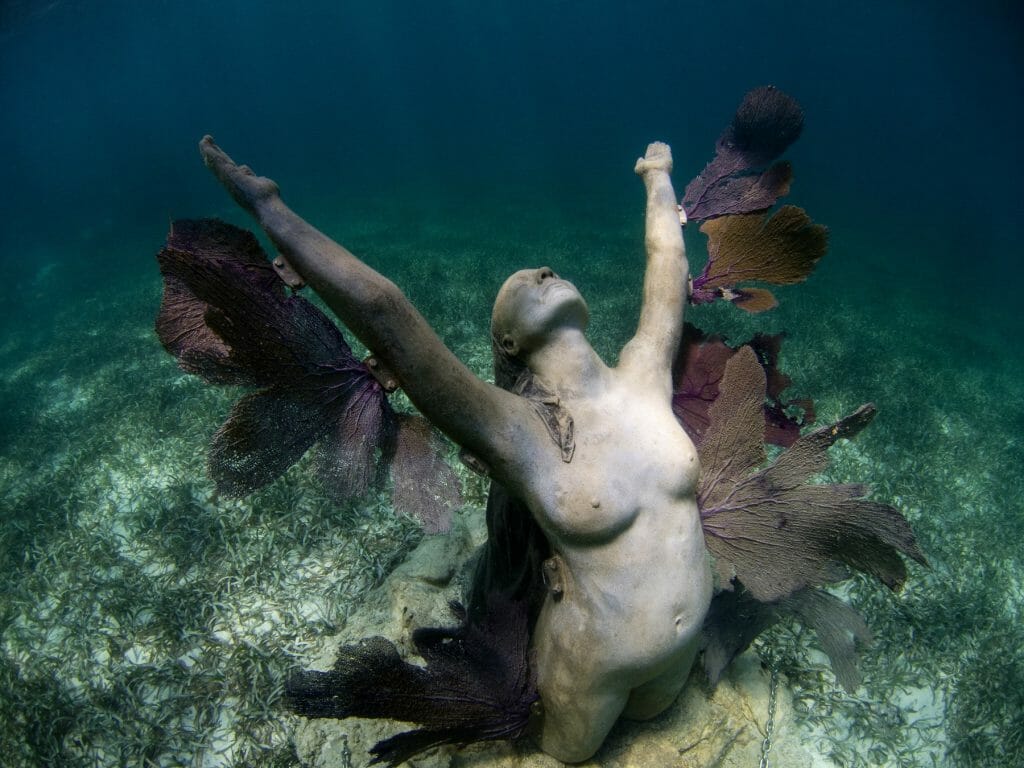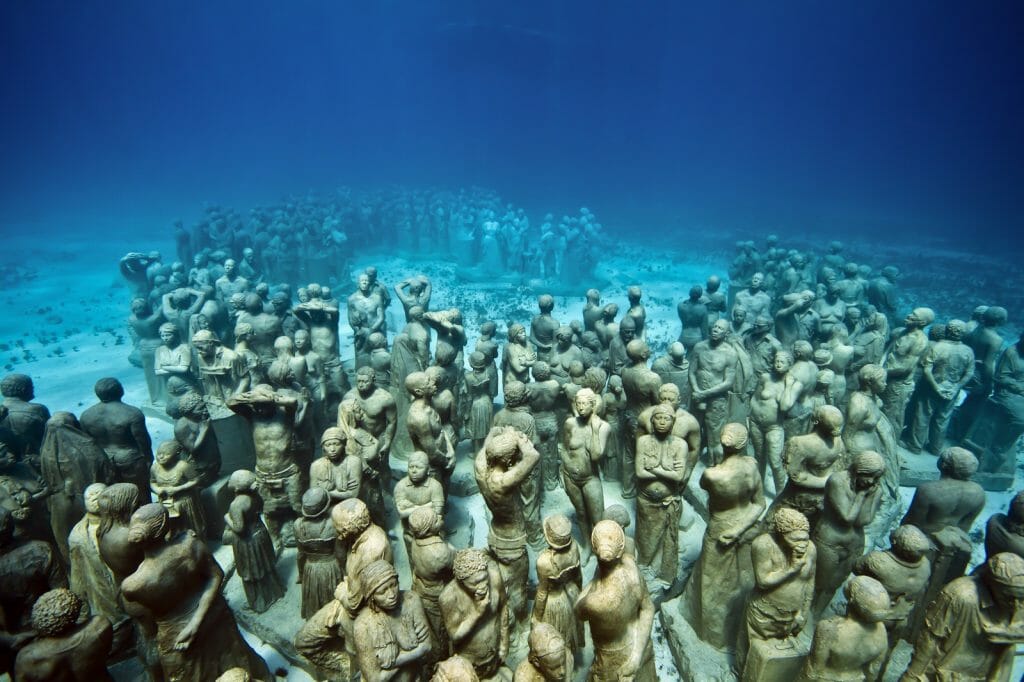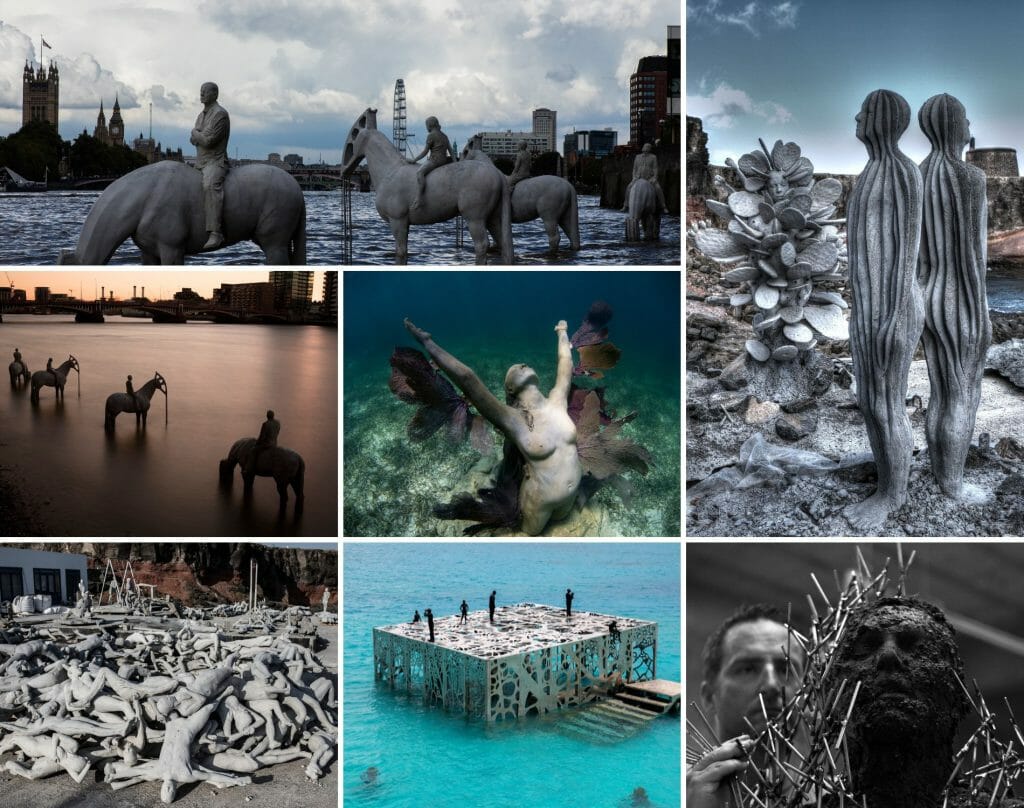The Surprising Transformational Power of Eco-Friendly Art

The Surprising Transformational Power of Eco-Friendly Art
An exclusive Interview with Jason deCaires Taylor
Jason deCaires Taylor is a sculptor, environmentalist, and professional underwater photographer. He graduated from the London Institute of Arts in 1998 with a BA Honours in Sculpture. Taylor became the first of a new generation of artists to shift the concepts of the Land art movement into the realm of the marine environment. He has received numerous sculpture and photography awards, is a member of The Royal Society of Sculptors, an Ocean Ambassador to DAN (Divers Alert Network), an Ocean Exemplar of The World Ocean Observatory, and a featured TED speaker. Taylor has been recognized for both creativity and inspirational leadership in recent years by Fast Company and Global Leaders Today. Taylor was awarded The Global Thinker Award by Foreign Policy and was described as the Jacques Cousteau of the art world.
Liane Buck: Thank you for being with us, Jason. Tell us a bit about how this journey of creative wonder started?
Jason Taylor: Um, it’s sort of, uh, started by chance. It wasn’t something that I had planned for a long time. I had actually done lots of different jobs, different professions. I studied sculpture at art college. But then, when I graduated, I went off into lots of different worlds, and I worked in set design, and I worked for a photography company. I learned to teach scuba diving, and I just went off on this journey of exploration and trying different, different professions out. Um, but with no, no real sort of, uh, objective, I should say. Um, but later on in life, I found myself working in the diving industry. I was just sort of thinking about the underwater world more from a more, from an artistic point, rather than from a, uh, you know, an adventure point of view or a tourism point of view.
I started to think about it, and, as you know, two-thirds of our planet is water. Um, but we’ve barely discovered 10% of it. And, artistically, we’ve, you know, we haven’t even touched the surface.
I think a lot of artistic representation of, of our seas, of the underwater world is generally quite negative. I believe we have this fear towards the sea and fear towards the oceans from all these depictions of the ocean, strange ocean creatures, and ships sinking. And I think there’s almost negativity attached to it. So, I wanted to look at the underwater world from a different point of view and see it more as a creation of life and show how our lives are linked to it.

Liane Buck: That’s, that’s very interesting. With that answer, you answered the second question, which I was about to ask How did the Oceans become this essential part of your life?
Jason deCaires Taylor: We always fear the unknown, but this colossal unknown is on our doorsteps.
Liane Buck: What inspired you to create these unique works of art? How do you elaborate on the forms and shapes of your underwater sculptures? Where do these ideas come from? Do they come from a collective imagining of things, or do you create each piece of art based on the location and the utility it will serve?
Jason deCaires Taylor: There were lots of different and practical factors: The depth, the light, the exposure to strong currents to, uh, to, you know, extreme weather. There are lots of practical considerations. They’re very different from doing land-based works. I try to sort of do the “artworks” connected to the country and the community that lives alongside them. So, most of them represent local people and local communities. But, they also try to tell stories that are quite global and reasonably related to the people there. So, there are a lot of factors. And then there’s also seeing how things are colonized—so seeing what, what Marine life exists there, the shapes, the forms, the different species, how they will alter the work eventually. And so that a dictate its form, structure, and composition.
Liane Buck: Interesting that you say that. The first work of art I saw from you was the one in the Caribbean ensemble where you have all those statues representing women, men, and children, all victims of the slave trade. Seeing your artwork there brought me the sensation that you provided them with an ancestral type of healing. Their stories needed to be told, to freeze in a (stone) matter of their plight and suffering. Also, it evokes a mirror effect that also permeates the entire south of the United States and countries below the equator. So, in one way or another, I think you are writing in stone their stories. You are sculpting the untold story of the world, right from the deepest places of our collective unconscious. That is one of the many reasons I appreciate your work deeply.
Jason deCaires Taylor: I certainly always wanted to try. we live in fast-changing times. We see we are subject to so many images and a barrage of information all the time. So there’s something really important about sculpture enabling us to freeze moments or capture a moment and tell a story.
For me, what’s more interesting is when it’s underwater, it instantly feels like something, a retrospective event. Even if the sculptures are brand new, they start to change even after a few days. So, it feels more like an archeological experience than a contemporary art experience. And so that, for me, it contextualizes things, maybe emphasizing the water. So, it makes it feel like it’s part of our story.

Liane Buck: Your work, aside from being exquisitely artistic and beautiful, seems to have an intricate mystical nature. Much of your work reminds me of the ethereal landscape of the “Angkorian Kbal Spean.” That place is described as “a spectacularly carved riverbed, set deep in the jungle to the northeast of Angkor. The site, now an archeological treasure, holds sacred images that tell the stories of ancestral traditions and beliefs. Do you see your work as an artistic expression, and at the same time, they function as thresholds of other dimensions?
Jason deCaires Taylor: That isn’t easy. I mean that I certainly use the “works” as a portal. I always think of them as frosting an interface or an access point into a different world. It is how the seas are embedded in our consciousness. I think. So, I kind of, yeah, definitely use the works to gain access into new worlds, whether they are spiritual or not.
I’ve always tried to open doors into different worlds, and that’s why I’m very much interested in not just working in the same places. I’ve tried to look at different environments. And so, I’ve worked in rivers, lakes, fjords, oceans, and seas. I like the idea that each one of those places is unique in its own right. And has this incredible wealth of life that is right under our noses and that very few people know about.
Liane Buck: No doubt your sculptures will be part of the Legacy of Planet Earth. Not only because you have immortalized the images (through sculptures), but you gave life to pungent historical portrays of Humanity, such as “the flows of Human Migration.” Did you have this intention in mind, or was this something that became an afterthought?
Jason deCaires Taylor: That has been my biggest intention. I think I use a lot of human figures in those works. I think that I find that a very good way to tell again that we are natural ourselves. But we tend to think of everything as being manmade or natural. And in the process, forget that we are natural and we are connected to the world. But we are obviously part of the same living system. We’re all interdependent.
It’s very important that we re-establish that connection so that we find a way to relate. I think we seem to relate to things in a slightly narcissistic way: where we must see a part of ourselves in what we are looking at to be able to relate to it.
That’s very much dictated why I’ve used human forms. They communicate with lots of different cultures and communities. Also, I think we have more empathy when we see the human quality in things.
Liane Buck: Do you consider your art as a form of social action? How do you find the balance between aesthetic contemplation and (Art) Activism?
Jason deCaires Taylor: Yes, definitely. I mean, there are a lot of different pieces.
Some of them are very critical. Some of them are just temporary activist pieces. Others try to take a broader view of Humanity. I try to deal with the importance of shining a light on the destruction of our natural world. That is the greatest threat that I know. It is a scene, the biggest thing we’re ever facing. There are obviously a thousand issues in between all of that. But I think ultimately, we have to readdress our balance with Nature.

Liane Buck: The Transcendental Nature of your art shows a delicate web of relations, not only between us humans, but all the living creatures, especially those from the Ocean habitats. If you had the chance to change the world with one wish, what would that be?
Jason deCaires Taylor: I would like to see it. We have to develop a new way of governance, a new way of choosing leaders, and another way of organizing communities. So, they’re in control of the environment around them. That’s obviously fundamental, but I think now in need to be going; further, we need to be looking at ways of reclaiming the past, we need to be rewinding all the areas that we’ve changed. We need to be taking down all the unnecessary buildings.
But it comes down to land use. And I think we have to revise how we own the planet or own our land. I don’t think individuals should own the land.
Even countries, the way we’ve carved up the planet with borders and front frontiers. I think the ocean is a perfect example of that. Those lines, those arbitrary lines have no significance because everything’s interconnected, and what happens on one part affects the other part. All private lands should be put back into the public domain.
Liane Buck: Among all the Plethora of inspirational factors that probably populate your personal “Imaginarium,” could you name a book and an artist that changed your life or shifted your perspective on things?
Jason deCaires Taylor: Yeah, of course. Obviously, I had different inspirations in terms of books at different points in my life. For example, there was a Marine biologist, an author called Callum Roberts, who had written a book called “The the Ocean of Life: The Fate of Man and the Sea.
It’s a really incredible read, and it clearly identifies all the critical issues facing our oceans and comes up with some brilliant solutions and ideas. And he’s been a very influential character for sure. In terms of artists, when I was young, I was interested in land arts, and I went to an art college that was not your standards college. Some of the tutors were outward-looking. And I remember, when I went in, I’d always worked on desks or easels and within a certain space. But, when I went to this college, they said, the one thing you’re never allowed to do is you’re never allowed to have a desk.
We had to work in the open space, and we had to think of a three-dimensional environment. I hated it because I’d have to bend down on the floor, but it forced me to not just think about the studio.
I would go out and explore forests and urban areas. I automatically started thinking of the world as a canvas rather than just being this desk and this small space. I learn to think outside the box.
Then obviously, the major artist who was really prolific when I was young was Christo (https://christojeanneclaude.net/ ), who did all these huge installations. He did projects that lasted, you know, ten years, 20 years, and I was really fascinated by how he maintained that level of endurance and single-mindedness. So I think some of the projects I’ve worked on have gone on for quite a few years, and they’ve required a certain determination to actually finish them. But I’ve always finished the projects.

Liane Buck: For someone with such an amazing conceptual mind and imaginative and inspired art, how do you cope with the ugliness that can be felt in the world today?
Jason deCaires Taylor: Very difficult, definitely very difficult. It is a very difficult thing because, ultimately, I think the systems that are governing our planet are clearly not functioning. They need to be completely reimagined.
We need to reset our relationship as Humanity globally completely. But how do we get that done? Even if we do that through complete collapse, which is what we’re heading to, or whether we do it proactively or incrementally. I’m not quite sure.
So, I range from feeling moments of hope and despair. But there are certainly stories of positivity because, I think inherently, most of us have good intentions. So, yeah, but I think the systems in place, unfortunately, benefit only the people who don’t have good intentions. And that needs to be changed.
Follow Ministry Earth on Facebook, Pinterest, Instagram Linkedin
Editor at OMTimes Magazine| Creatrix | Book reviewer & blogger | writer | cupcake connoisseur | hopeful cynic| Recovering cat lady| Fish Tank aficionado | Ecstatic Rainbow Mother by Day Ninja by Night| Fairly Odd Mother of Small creatures.






